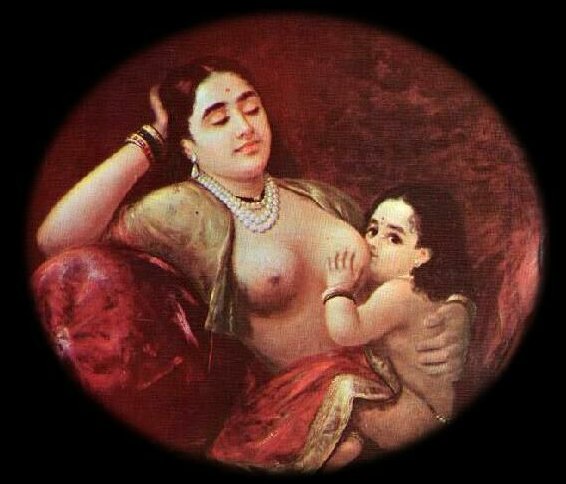Description
Raja Ravi Varma, one of the most famous painters in India, is known for his exceptional ability to merge Indian tradition with Western artistic techniques. His painting "The infant child" ("The Suckling Child") is a masterpiece that clearly illustrates this unique combination of styles and techniques. Varma, born in 1848 in the princely state of Travancore, stood out for his skill in portraying mythological scenes, as well as daily scenes and realistic portraits.
"The infant child" is an evocative representation of motherhood and childhood. The work focuses on the figure of a mother and her infant son, an issue that has been recurring throughout the history of art, but that varies reinvents with her particular approach. The mother, with a serene expression of love and dedication, holds her son in a natural and protective hug. The delicacy with which this intimate moment is worthy is worthy of admiration. The child's maternal tenderness and innocence are perfectly embodied on the canvas, creating a warm and cozy atmosphere.
In terms of composition, the painting stands out for its simplicity and balance. The mother occupies the center of the scene, with the child supported by her lap. This approach to the main characters ensures that the viewer is not distracted from the essential interaction between mother and son. The mother's inclined body posture towards her child and the gaze that both share is a powerful testimony of the human connection and the protective instinct.
Varma uses a subtle color palette, dominated by earth tones and warm colors that accentuate the naturalness of the scene. The folds of the clothing and the texture of the skin are treated with thorough detail, which shows the influence of the western realistic techniques that Varma incorporated into his work. The soft lighting highlights the contours of the figures and creates a subtle game of lights and shadows that adds depth to the painting.
It is impossible to talk about Ravi Varma without mentioning his ability to balance two artistic worlds. Formed in the canons of European realism, Varma knew how to interpret and value the cultural wealth of its own land. His representation of traditional Indian clothing in this painting is an example of his dedication to capture the essence of his culture. Each fold, each Sari ornament that the mother carries is painted with a rigor that demonstrates both her appreciation for detail and her respect for cultural authenticity.
In addition to their technical skills, which really distinguishes Varma is its ability to evoke deep emotions through their images. "The infant child" is not just a visual representation; It is also a window to a universal human experience: the relationship between mother and son. This painting, then, is not only a testimony of the talent of Varma, but also a celebration of the universality of motherhood.
Through "the infant child", Ravi Varma Raja offers us a work that transcends time and space, connecting viewers with an intrinsically human experience. Attention to detail, the combination of styles and the ability to evoke emotions are characteristics that make this painting a jewel in the vast repertoire of varma. When observing this work, one not only contemplates a scene of maternal love, but also appreciates the genius of an artist who knew how to integrate the east and the west into a single canvas.
KUADROS ©, a famous paint on your wall.
Hand-made oil painting reproductions, with the quality of professional artists and the distinctive seal of KUADROS ©.
Art reproduction service with satisfaction guarantee. If you are not completely satisfied with the replica of your painting, we refund your money 100%.

